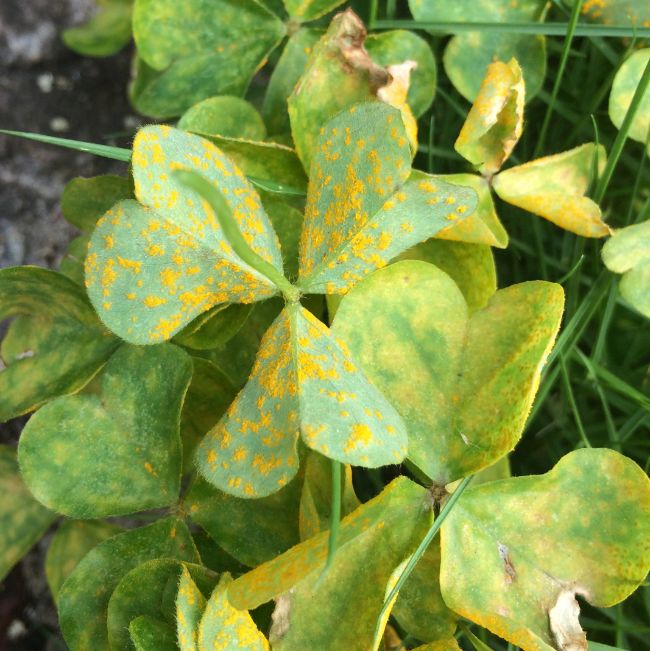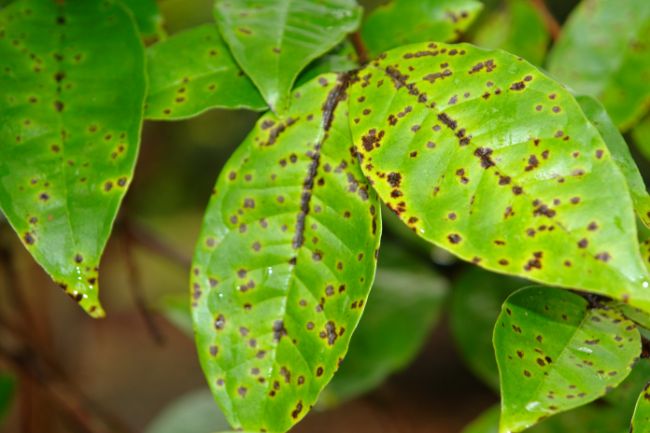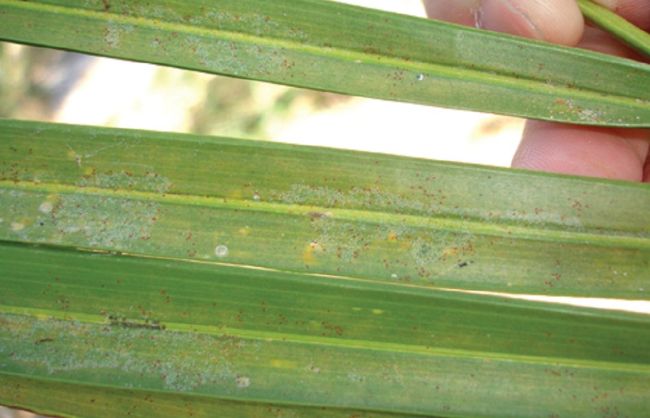Disfigured leaves are upsetting on any plant, but they are especially unwelcome on houseplants that are kept for their beautiful foliage. Downy mildew is a common cause of leaf spot, although there are other causes as well. Let’s look at why rust spots on leaves occur, how to treat the problem, and the best ways to prevent it from recurring.
Causes of rust spots on leaves: Rust is caused by a group of fungi from the Pucciniales order. It shows up as a spread of orange, yellow or red spots on the foliage. High humidity and prolonged leaf wetness encourage these pathogens. Removing affected leaves, drier conditions, soil amendment, or chemical sprays may resolve the problem.
Overview of rust spots on leaves
Colored spots appearing on your plant’s precious leaves can be alarming, but don’t panic. The problem can usually be mitigated with treatment or improvements to the facility’s environment. As long as you identify the problem correctly and fix it quickly, you can often minimize your losses to just a few leaves.
Powdery mildew is a common cause of foreign-looking, colorful spots. What you see on the rust-affected leaves are actually caches of reproductive spores. When these spots mature, the spores can spread throughout the plant or surrounding vegetation. It is important to solve the problem before it gets worse.
Although rust fungus is a classic culprit, there are other causes of leaf spots that can look similar, so it’s important to identify the cause before treating:
- A number of leaf spot diseases produce muted spots similar to fungal rust.
- Brown spots and spots on the leaves can be caused by incorrect pH and lack or overdose of specific nutrients.
- Residues of salts in the soil from excess fertilizers can affect the roots and lead to spot problems.
- Pest infestations can cause mottled spots. Spider mites are a particular hazard, and their small size means they can be missed during a routine inspection.

Rust disease on plants
Rust is caused by a group of fungi from Pucciniales order. It shows up as multiple orange, yellow or red spots on the foliage. Their size varies but is usually less than a ½ inch in diameter. As a whole, these organisms attack plants of all descriptions, but each rust subtype can typically attack only a very narrow range of plants.
The spots created by fungal rust are actually deposits of powdery spores. These can be partially rubbed off with a tissue or cloth, so the good news about fungal rust is that it’s easy to diagnose. Just wipe a spot and see if the color transfers to the material.
Spores that cause rust spots can be carried by air currents. They remain dormant until conditions are favorable. The spots occur randomly – literally where the wind blows them – and can form on either side of any leaf. Because rust spores require consistent moisture to grow, they usually form first on lower, inner foliage where there is less light and ventilation.
Treat and prevent rust spots on leaves
Rust fungi tend to attack weakened plants: healthy specimens are much more resistant. A rust infection can be a sign that the plant is not receiving optimal care.
Once you have determined that your plant’s problem is fungal rust, immediately remove the affected leaves and dispose of them safely. Don’t put them on the compost pile! You can cut spots off a leaf you want to save, but carefully discard the spores so they can’t contaminate other plants.
In order to grow and “bloom out”, fungal rust needs the underlying foliage to remain wet for at least 12-24 hours. Good air flow can keep the disease at bay. Double-check your plant’s care and make sure it gets adequate ventilation – especially if you have a moisture-loving plant in a humid environment.

In other words, the basic treatment for rust is also the way to prevent it from taking hold: Avoid wet conditions.
Here are some tips:
- When wateringtry to wet the soil and not the foliage.
- Separate your plants so air can circulate around them.
- Water early to give the plant time to dry during the day.
- Wait with fog.
- Use rust-resistant varieties of your favorite plants if available.
- Try to make sure that the plants you buy are free from diseaseand quarantine them for a few weeks after purchase.
If you want to treat more aggressively, either a chemical or natural treatment can be effective:
Fungicide sprays
Copper-based all-purpose formulas can limit spore reproduction, but they do not completely eradicate the disease. Organic sulfur and antifungal soap sprays are equally effective. Follow label directions and repeat weekly to 10 days until spotting stops.
Home treatments
Spray the plant with a solution of one teaspoon of baking soda to one liter of water. Another popular spray recipe is to let ½ cup of finely chopped garlic sit in a gallon of water for 24 hours before application. Repeat every five days until symptoms stop.
Other leaf spots that may look like rust
Leaf spot diseases
Leaf spot pathogens are a large group of organisms that can cause leaf spots. Some fungal infections work much like rust; others are caused by bacteria or even a virus. Some causes of leaf spots are often limited to certain plant families, but most plants are vulnerable to at least one type.
These pathogens can live on leaves without becoming visible until wet conditions allow their populations to explode. They are normally non-fatal and result in mostly cosmetic damage; Of course, disfigured foliage is a serious problem for an ornamental houseplant!
Leaf spot infection produces circular lesions of various sizes. These can be either raised or depressed and can have clearly defined or fuzzy edges. Spot colors vary from brown to reddish-brown or black. Sometimes the center of a patch will dry and fall out, leaving holes in the foliage.
Isolate the plant to prevent further contamination, and give them the treatment recommended for rust disease: Spray with a copper-based or sulfur fungicide or use a baking soda or garlic mixture weekly at the onset of the disease. These solutions do not completely eliminate Leaf Spot infection, but they help prevent further spore germination.

Malnutrition
The lack of certain nutrients can cause leaf spots along with wilting or yellowing leaves – but be aware that this is not the most common cause of spots. Plants are not particularly susceptible to deficiencies in fertilization; they produce most of their “food” from photosynthesis.
These common deficiencies can cause leaf spots:
Calcium
Deficiency of this vital element results in wilting of new growth, curled tips and yellow or brown leaf spots. The spots are usually outlined by a dark brown border. These appear on older, mature vegetation near the base of the plant.
The problem can develop quickly; the spots start small and increase in size as the syndrome progresses. With proper care, you can stop but not reverse the damage.
The treatment depends on why the plant is not getting enough calcium. An acidic pH of 6.4 or lower can cause difficulties with calcium absorption. If the problem is indeed a lack of calcium in the soil, a lime-based amendment can correct the problem. Quality soil mixes that use peat or other naturally acidic ingredients often contain lime for adequate calcium availability.
Magnesium
A deficiency of this macronutrient can show as yellowing leaves with a marbling of small brown spots or rust spots on the leaves. An increase in magnesium can remedy the situation. Some fertilizers include both calcium and magnesium.
Both of these deficiencies should be fairly easy to distinguish from fungi that cause rust spots on leaves. But determining the correct cause will make a world of difference in nursing your plant back to health.
Overfeeding and nutrient burning
As mentioned, malnutrition is not the most common problem for houseplants. In fact, too much sodium, potassium, magnesium or other elements can cause problems. Don’t just add more fertilizer if your plant looks bad—overfertilizing can burn sensitive roots and cause brown or rust spots on leaves and brittle edges.
Leaf damage from overfeeding can occur over the entire plant or on just a portion of it. Wilting and stunted growth are other symptoms.
The treatment for over fertilization is to flush the soil. This washes away excess elements from the plant’s roots. Remove any fertilizer inputs you may have and run extra water through the soil. Allow the container to drain completely. Repeat one or more times.
Leaves damaged by nutrient burn will not recover, but new growth should be healthy. Even if you are not sure if your plant has been over fertilized, flushing the soil will not harm your plant. It’s good to do every month or so during the growing season as regular maintenance.
Read my guide to fertilizing houseplants for more information on how to avoid deficiency and over-fertilization problems.
Extreme pH
Nutrient deficiency and oversupply problems can often be traced to your soil’s pH level. A reading of six to seven pH generally provides the greatest availability of nutrients to plants. If the soil is outside of your plant’s preferred pH range, the roots can be “locked out” from absorbing the elements it needs.
If pH is the problem, adding more nutrients can actually make the problem worse. Excess fertilizer can lead to salt build-up that changes the soil’s pH. It seems counterintuitive, but eutrophication can cause malnutrition.
If you find rust spots on leaves, or leaf spots of any color for that matter and aren’t sure of the cause, find out your plant’s required pH and test your soil to see if it’s in the right range.
Pro tip: pH meters are a good option, but using a pH dye kit is also accurate enough for basic soil assessment.
Soil amendments can bring the pH to the right level: a lime compound makes the soil less acidic (raises the pH), while sulfur and organic materials lower the alkalinity (lowers the pH). Be aware that soil with peat or other organic matter tends to be more acidic – and this effect can increase over time as the materials break down.
Pest damage

Spider mites can also cause leaf spots. If you see small white, yellow or even brown/rust-colored spots scattered across the leaf surface, you may be dealing with a pest infestation.
It is important to diagnose a spider mite problem as early as possible; these little terrors can weaken and eventually kill your plant if left untreated.
Look closely at your leaves and check for small dark spots that may (or may not) be moving. A magnifying glass is helpful. You may see small webs if the infestation is well established.
Treatment requires persistence. Rubbing alcohol kills on contact if it is dabbed directly on the pests. Both horticultural oil and insecticidal soap are effective in treating larger colonies. Coat all leaves on both sides – these substances must come into contact with the mites to work. They have no residual effect, so reapply every other day until the mites are gone.
Effective treatment for rust spots on leaves
If you have found rust-colored spots on the leaves of your houseplants, the main priority is to identify the cause. Determine if it is fungal rust disease or one of the other leaf spot conditions that cause similar damage. Then you can choose the right treatment and nurse your plant back to health.
 pyomn
pyomn



